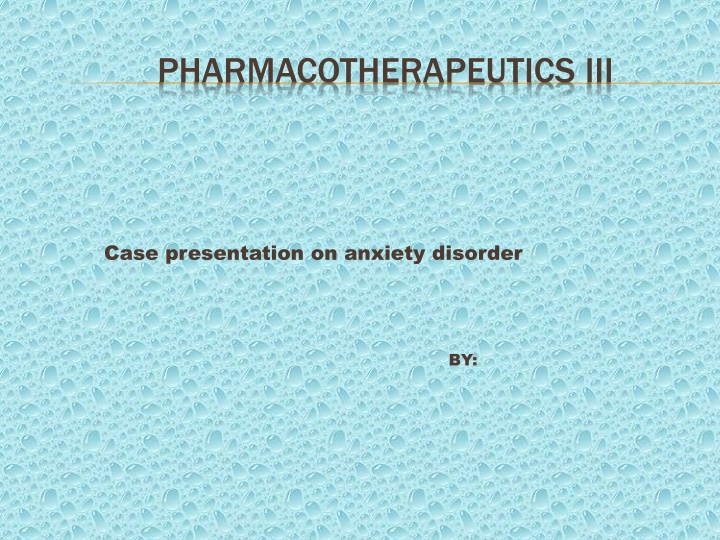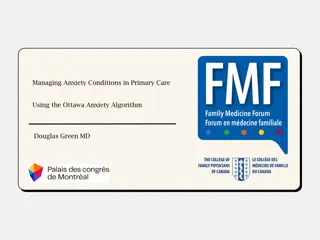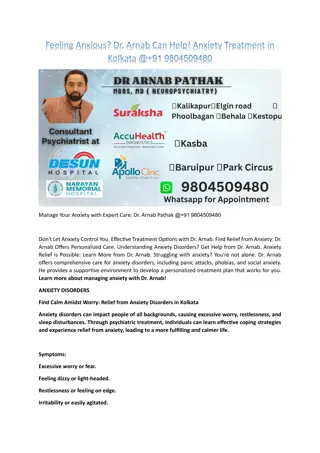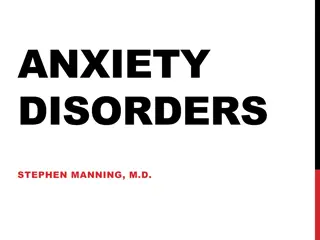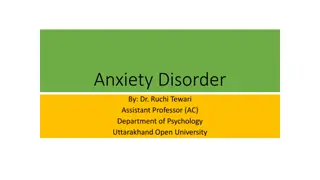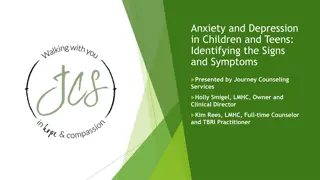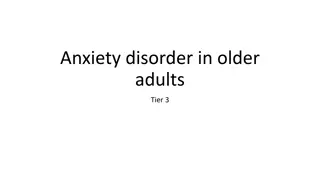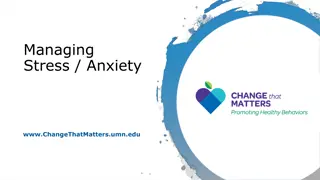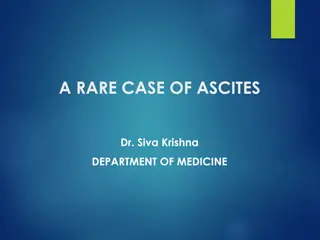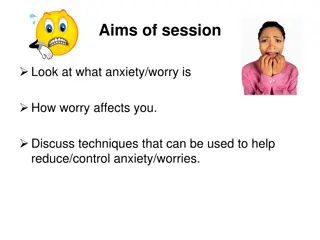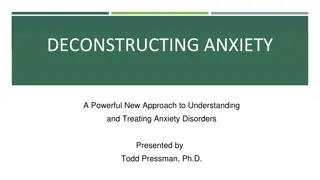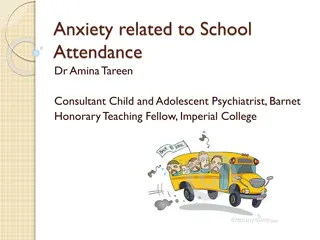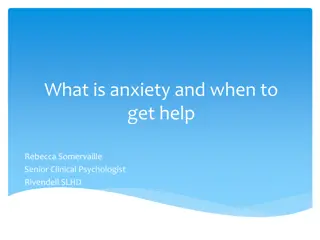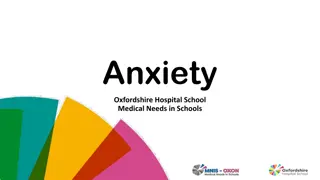Case Presentation: Managing Anxiety Disorder in a 45-Year-Old Female
A 45-year-old female with a history of mild depression and anxiety presents with chest discomfort, palpitations, and worry. Physical exam reveals elevated heart rate and abnormal lab results. Diagnosis of anxiety disorder is made, with plans for cognitive-behavioral therapy and pharmacological treatment to alleviate symptoms and prevent progression. Detailed assessment and treatment plan are discussed.
Download Presentation

Please find below an Image/Link to download the presentation.
The content on the website is provided AS IS for your information and personal use only. It may not be sold, licensed, or shared on other websites without obtaining consent from the author.If you encounter any issues during the download, it is possible that the publisher has removed the file from their server.
You are allowed to download the files provided on this website for personal or commercial use, subject to the condition that they are used lawfully. All files are the property of their respective owners.
The content on the website is provided AS IS for your information and personal use only. It may not be sold, licensed, or shared on other websites without obtaining consent from the author.
E N D
Presentation Transcript
PHARMACOTHERAPEUTICS III Case presentation on anxiety disorder BY:
ANXIETY DISORDER PATIENT SCENARIO: Here is a 45 years old female patient admitted to female medical wards diagnosed as anxiety disorder and hospitalized for 8 days HISTORY OF PRESENT ILLNESS: patient complains chest discomfort since 8 days non radiating relieved on rest and increases when she feels anxiety and palpitation since 8 days. she had some family problems that lead to anxiety SOAP NOTE: SUBJECTIVE EVIDENCE: Patient complains of chest discomfort and palpitation since 8 days. PAST MEDICAL HISTORY: Mild depression with anxiety. PAST MEDICATION HISTORY: PAST MEDICATION HISTORY: Not known.
OBJECTIVE EVIDENCE: VITAL SIGNS are normal .pulse rate was 104 bpm Her CBC shows mild elevation in WBC(11,900 cells/cu.mm) slight decrease in Hb (11.7 gm%) and MCH(24.4g/dl) and MCHC(28.8g/dl) ESR was elevated(25 mm/hr) urine examination was normal CK MB was increased: 32U/L(0-26 U/L) Troponin T negative ECG: T wave inversion in v1-v6 12 lead ECG: ECG changes may be diagnostic of acute myocardial infarction, but a normal ECG does not rule out ischemia or infarction. New transient ST-segment deviation or T-wave inversion in multiple precordial leads indicates a high likelihood of acute coronary syndrome CK MB VALUES ARE ELEVATED IN MYOCARDIAL CONTUSION ,MI ANDACS .
ASSESMENT: By the above subjective and objective the physician diagnosed the condition as ANXIETY DISORDER. PROBLEM LIST: Chest pain Palpitation Anxiety CHEST PAIN: This is due to anxiety. Studies have shown that non-cardiac chest pain in the emergency setting may be associated with psychiatric disorders, especially panic, anxiety, and depressive disorders. Anxiety causes chest pain in 15% of patients secondary to hyperventilation and somatoform disorders. PALPITATION: An abnormal or uncomfortable awareness of forceful or rapid heart beats that is a relatively nonspecific symptom and not a reliable predictor of any particular cardiovascular disease, arrhythmia, or psychiatric disorder due to stress. ANXIETY: It is an emotional state commonly caused by the perception of real or perceived danger. A condition defined by excessive anxiety and worry, with difficulty controlling the worry, occurring more days than not for at least 6 months.
PLAN: GOALS OF THERAPY: To subside symptoms like chest pain and palpitations To reduce the panic attacks Start to gain independence over what can be a debilitating condition. cognitive-behavioral therapy, or CBT. This approach teaches that thought influences behavior, which in turn influences action. To prevent alleviation of disease and progression to suicidal thoughts CHEST PAIN: ASPIRIN(325MG) one dose given on 2nd day of admission ECOSPIRIN : ASPIRIN(150MG)+CLOPIDOGREL(75MG) 0-0-1: given for 3days from 2ndday of admission ATORVASTATIN(40MG) one dose given on 2ndday of admission. ECOSPIRIN GOLD:0-0-1:ASPIRIN(75MG)+CLOPIDOGREL(75MG)+ATORVASTATIN(10MG) last 5 days of therapy. NITROFIX:ISOSORBIDE MONONITRATE(10MG)1-0-0 given for 5 days of therapy ASPIRIN Pain a) a) 325 to 650 mg ORALLY every 4 hours; MAX: 3.9 grams/24 hours
ASPIRIN Myocardial infarction; Prophylaxis a) 75 to 100 mg ORALLY daily The antithrombotic effect of aspirin occurs by an irreversible inhibition of platelet cyclooxygenase. CLOPIDOGREL: Myocardial infarction, Recent - Thrombosis; Prophylaxis a) 75 mg ORALLY once daily Clopidogrel is a prodrug that is metabolized by CYP450 enzymes to the active thiol derivative. The active thiol derivative, selectively and irreversibly binds to the adenosine diphosphate (ADP) P2Y12 receptor on platelets. This prevents ADP from binding and activating the glucoprotein GPIIb/IIIa complex, which is necessary for platelet aggregation ATORVASTATIN: Disorder of cardiovascular system, in patients with multiple risk factors for coronary heart disease; Prophylaxis 1) initial, 10 to 20 mg ORALLY once daily; OR initial 40 mg ORALLY once daily if reductions of greater than 45% in LDL-C are needed; dosage range is 10 to 80 mg once daily; following dose initiation or titration, lipid level assessment should be done within 2 to 4 weeks It is a potent inhibitor of 3-hydroxy-3-methylglutaryl coenzyme A (HMG-CoA) reductase which is used for the treatment of hypercholesterolemia.
ISOSORBIDE MONONITRATE: Coronary vasodilatation: immediate release, 20 mg ORALLY every morning, then 20 mg 7 h later organic nitrates (nitroglycerin, isosorbide, pentaerythritol) readily enter vascular smooth muscle where they are converted to nitric oxide (NO) which acts as a cellular messenger eventually leading to activation of cyclic guanosine monophosphate (cGMP) and vasodilation PALPITATION: Stress Reduction MEGAPRIL:RAMIPRIL(2.5MG)1-0-1:ACE inhibitor given for 4 days of therapy from day 3 Indicated to reduce the risk of myocardial infarction, stroke, or death from cardiovascular causes in patients who are at high risk of developing a major cardiovascular event because of a history of coronary artery disease, stroke, peripheral vascular disease, or diabetes accompanied by at least one other cardiovascular risk factor (hypertension, elevated total cholesterol, low HDL, cigarette smoking, or microalbuminuria) .
METAZOK:METOPROLOL(25 MG)1/2-0-1/2 controlling aggressive, assaultive behavior in some psychiatric patients. Reported the use of metoprolol in 2 patients with intermittent explosive behavior who had been treated unsuccessfully with propranolol and carbamazepine. In one of the patients, explosive behavior had been controlled with 400 mg/day of propranolol administered over a period of several months. However, the medication was discontinued due to the development of depression. The rage attacks were subsequently controlled with metoprolol 300 mg/day. The second patient, a 35-year- old male, had received propranolol 160 mg/day over a period of two months, but the drug was discontinued because of increased sedation. The explosive behavior was subsequently controlled with metoprolol 200 mg/day with no further sedative effects noted. Beta adrenergic blockers are known to displace serotonin (5-HT) from the receptor, thus increasing the amount of circulating 5-HT. Decreases in 5-HT are associated with increased aggression, thus a drug that can increase the circulating 5-HT concentration may be able to modulate aggressive behavior . Alternatively, beta-blockers may minimize the dyscontrol of rage and violence by central blockade of beta receptors. The mechanism of action may involve beta- adrenergic blockade, which breaks the cycle of interaction between anxiety and adrenergically-mediated physical sensation
LANOXIN:0.4ML 1-0-0DIGOXIN:given for last 2 days of hospitalization Digoxin is indicated for the treatment of mild to moderate heart failure, and should be used with a diuretic and an angiotensin-converting enzyme inhibitor when possible Dose: 500 microgram (2 milliliter) into a single injection site ANXIETY : OLAN S:OLANZAPINE 5MG -0-1/2:for 6 days . Agitation - Bipolar I disorder initial, 10 mg INTRAMUSCULARLY; lower dose of 5 mg or 7.5 mg may be used if indicated; usual effective dosage range is 2.5 mg to 10 mg . Atypical antipsychotic in treating +ve and ve symptoms of schizophrenia. Dopamine and 5HT antagonist Patient complained sleeplessness for 3 and 4 th day of hospital admission INJ.LOPAZ:LORAZEPAM 1 AMP (2mg)for first day of admission and 3rdand 4 th day Anti anxiety-benzodiazepine Oral 2 mg every 6 hrs for 4 doses. Insomnia, due to anxiety or situational stress 2 to 4 mg ORALLY at bedtime
T.PETRIL MD:CLONAZEPAM:0.5 mg: -0-1:for day 2 and continued for day 4 to day 8 of hospitalization Benzodiazepine. Panic disorder a) initial, 0.25 mg ORALLY twice a day for 3 days, then 0.5 mg twice a day b) maintenance, may increase dosage by 0.125 to 0.25 mg ORALLY twice a day every 3 days to a MAX total daily dose of 1 to 4 mg (divided into 2 to 3 daily doses) T.ESCITALOPRAM:20mg 0-0-1 for 4 days from day 2. Anti anxiety and anti depressant drug. SSRI Initial 10 mg per day given and increased to 20mg per day only after minimum of 1 week ANXIT:ALPRAZOLAM:0.5mg 1-0-1 for 5 days from day 2 Anxiety a) immediate-release or orally disintegrating tablet, 0.25 to 0.5 mg ORALLY 3 times a day, may increase every 3 to 4 days if necessary; MAX daily dose, 4 mg in divided doses Is a benzodiazepine compound structurally similar to diazepam and exerts its effects by binding to various stereo-specific receptors in the CNS. Alprazolam possesses anticonvulsant, muscle relaxant, and anxiolytic properties similar to other benzodiazepines
MAHACEF:CEFPODOXIME 200mg for 5 days from day 3. 3 rd generation cephalosporin :prophylaxis for hospital borne infections(does not have neurological side effects) An PPI should be prescribed. DISCHARGE DRUGS: NITROFIX 1-0-0 FOR 2 DAYS ZAPIZ -0-1 FOR 5 DAYS ESCITALOPRAM -0-1 FOR 5 DAYS
Treatment of generalized anxiety disorder VENLAFAXINE HYDROCHLORIDE Adults (extended release): Initially 37.5 to 75 mg orally daily; may increase by 75 mg/day every 4 days to maximum 225 mg/day DULOXETINE HYDROCHLORIDE Adults (extended release): 60 to 120 mg orally once daily ESCITALOPRAM OXALATE Adults: 10 mg orally once daily PAROXETINE HYDROCHLORIDE Adults: Initially 20 mg orally daily; may increase by 10 mg/day increments once weekly to maximum of 50 mg orally daily FLUOXETINE HYDROCHLORIDE
BUSPIRONE HYDROCHLORIDE Adults: Initially 7.5 mg orally twice daily; may increase by 5 mg/day increments every 2 to 3 days to maximum of 60 mg daily IMIPRAMINE HYDROCHLORIDE LORAZEPAM (BENZODIAZEPINES) Adults: Initially 2 to 3 mg/day orally in 2 to 3 divided doses; range of dosing varies from 1 mg to 10 mg daily ALPRAZOLAM Adults: Initially 0.25 to 0.5 mg orally 3 times daily; may increase every 3 to 4 days to maximum daily dose of 4 mg although some patients may require higher doses DIAZEPAM ( BENZODIAZEPINES) Adults: 2 to 10 mg orally 2 to 4 times daily
